
Four Months Out: What Happened to our Food System and Why?
It’s been four months since Utah public schools closed on March 16 and I’d like to take the time to explain a bit about how our food system was impacted by COVID-19 and why. For some of you, these impacts may be obvious, but certainly not to all.
The U.S. food system is a complex web of farms, processors, shippers, packers, warehouses, millers, and final outlets including the retail grocery and food service industries, such as restaurants, schools, hotels, and hospitals. Most food products are heavily processed, only products such as fresh produce, eggs, and milk are packed and shipped directly to the grocery store or school. Due to the large degree of food processing required, farmers receive only $.11 cents on average (varies by product) of every dollar we spend on food. While food production does take place in all 50 states, most of our food comes from California and the mid-western states. Transporting food nationwide requires complex trucking, rail, and air shipping systems. Additionally, we import and export food world-wide, in 2018 U.S. food exports exceeded imports by about $11 billion.
Figure 1. US Food Supply Chain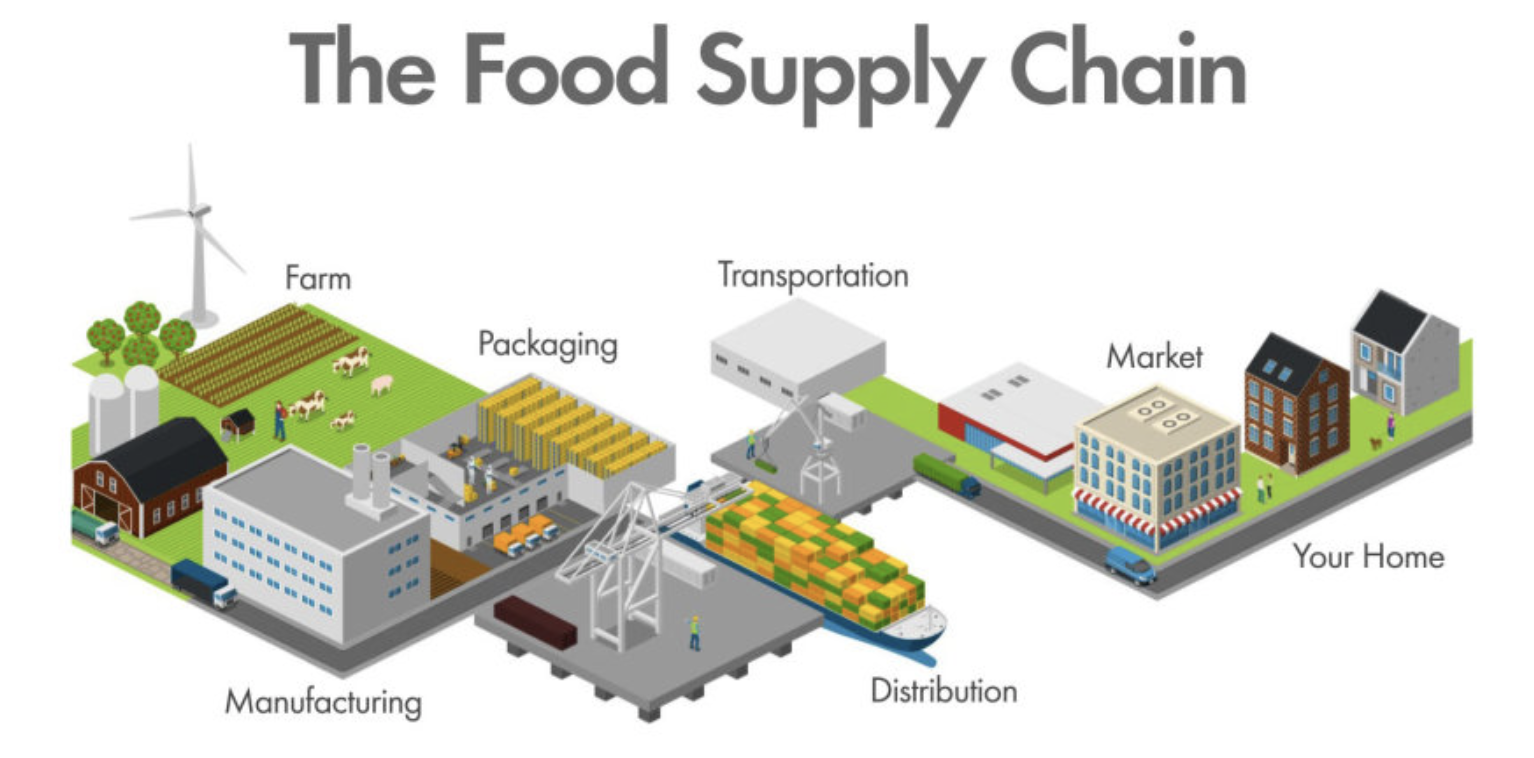
Source: https://money.howstuffworks.com/food-supply-chain-pandemic.htm
COVID-19 has impacted our lives a great deal, but it has especially impacted where and how we eat. Our food system has had to bend greatly due to both supply and demand shocks resulting from COVID-19. It has been said that while our food system is very efficient, it’s not very flexible. Here are a few questions you may have about the impacts of COVID-19 on our food system.
Why did we experience food shortages at the grocery store?
Our food supply chains are very efficient and employ “just-in-time” systems, where grocery retailers track customer behavior over time and only order what they need. This means there isn’t any extra inventory, and thus when consumers were told to stay home in mid-March, the spike in retail grocery purchases shocked the system and created shortages. These short-term shortages are ironed out in the longer-term, which is now the case in many parts of the country.
The increased spending at the grocery store resulted from stay-at-home orders and school closures. Americans were longer eating at school or work, nor meeting colleagues and customers for lunch. They weren’t even celebrating family events and successes with special dinners out. Many restaurants were closed or only providing limited curbside pick-up meal services. Additionally, food shortages led to increased grocery store pricing, early estimates show that grocery pricing nationwide increased by 2.6% between March and April of 2020.
As states opened in May and June, allowing dining at restaurants for example, consumer spending at restaurants rebounded a bit and grocery spending fell off. Nationwide grocery spending is still up 8.2% (as of July 1, 2020) from January 2020 levels, but down from its high of 73.7% on March 18 (Figure 2). National restaurant and hotel spending remains low at -33.8% but has improved since its low of -66.7% on March 31.
In Utah, overall consumer spending was 9.1% lower on July 1, 2020 than in January 2020. As of July 1, 2020, grocery spending was up 8.2%, down from a high of 109% March 16 (Figure 3) and restaurant spending was down 30.9% from January 2020 levels (Figure 4).
Figure 2. National Grocery Expenditures in Comparison to January 2020 Levels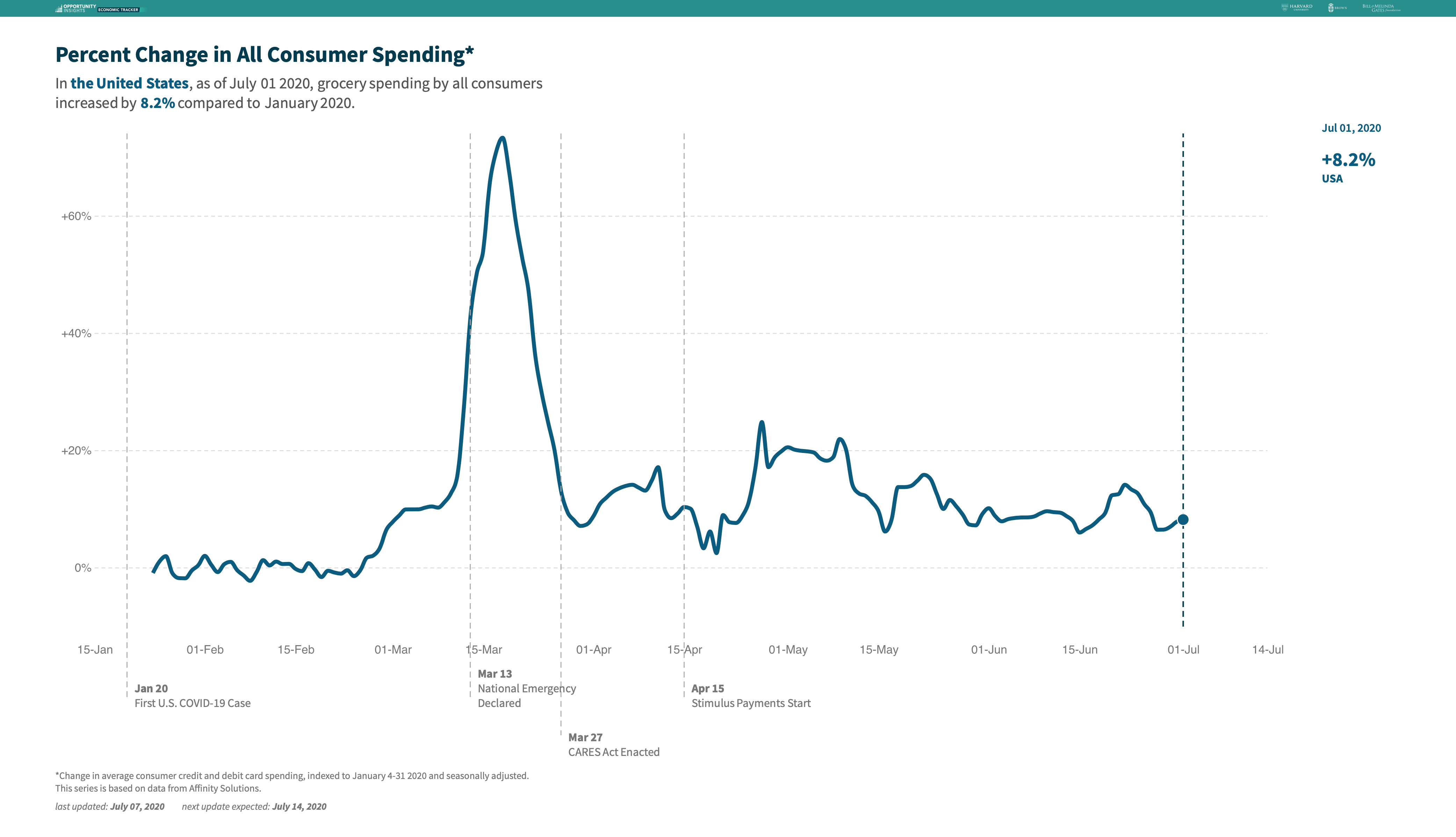
Source: https://tracktherecovery.org
Figure 3. Utah Grocery Expenditures in Comparison to January 2020 Levels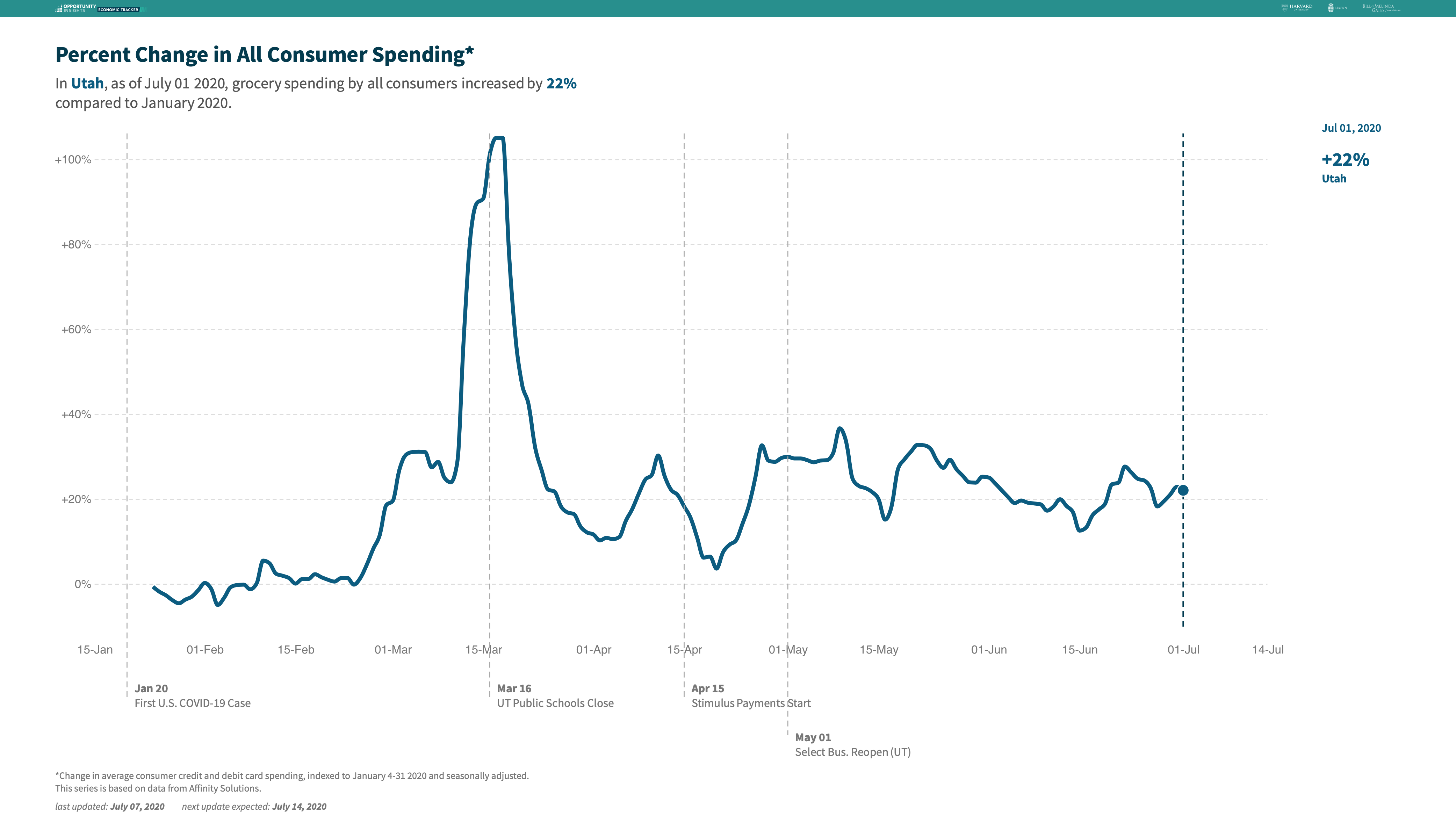
Source: https://tracktherecovery.org
Figure 4. Utah Restaurant/Hotel Expenditures in Comparison to January 2020 Levels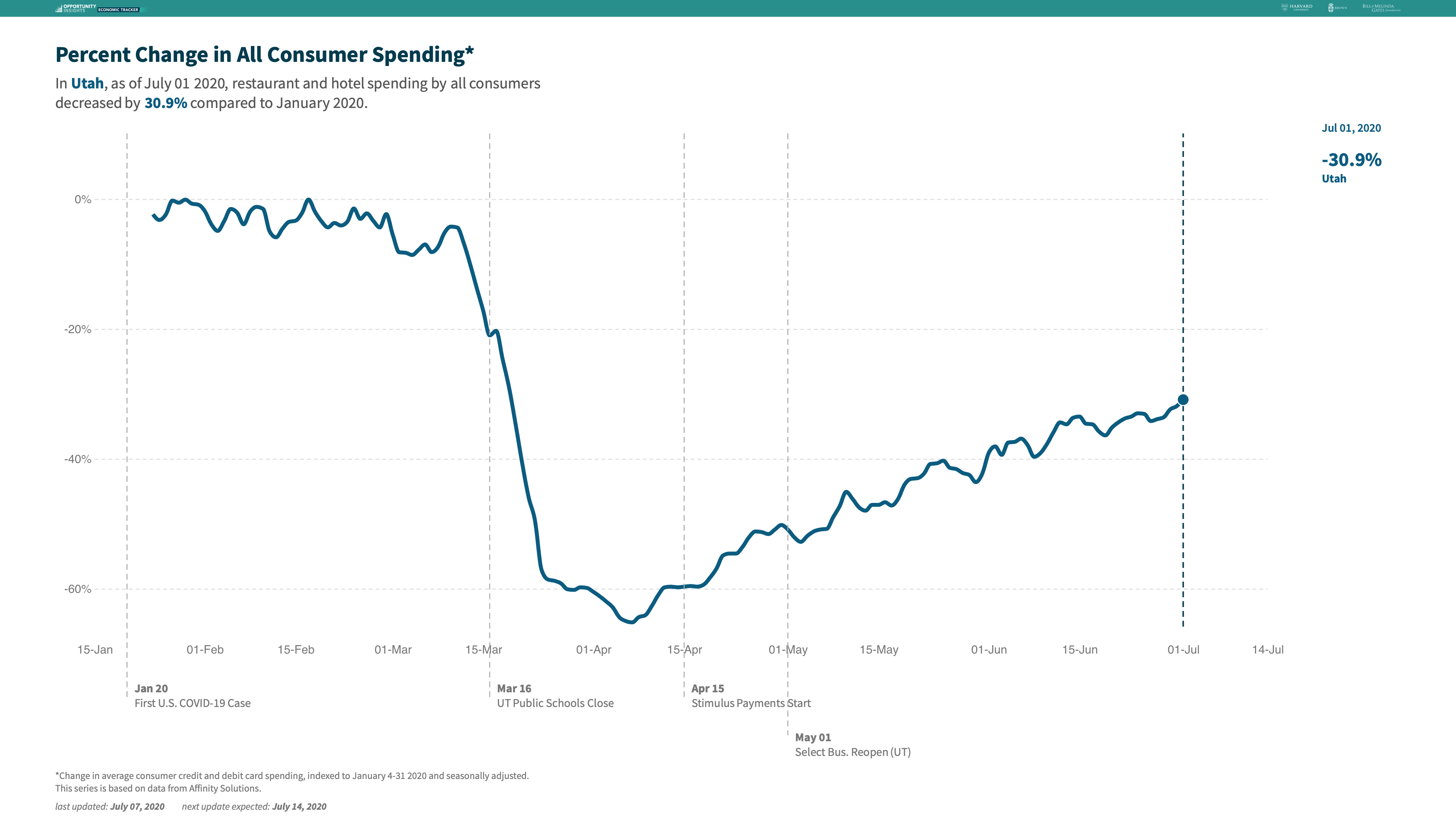
Source: https://tracktherecovery.org
Why couldn’t food bound for restaurants, hotels, and schools be rerouted to grocery outlets and food banks?
One of the primary reasons that food can’t be rerouted easily is that restaurants/hotels, schools, and retail grocery have completely different supply chains and the connections and relationships in one supply chain don’t transfer automatically to another. Also, the form and type of products used by each final market are different. For example, eggs destined for schools are often powdered, those headed for restaurants come in large packets of 36 or more, and those in grocery stores come in one dozen cartons. Milk headed to schools comes in small containers (8 oz.) and often include a chocolate option. The milk you buy in the grocery store is packaged in larger pint, half gallon and full gallon containers. Also, the variety or type of food product demanded by each final market can also be very different. For example, the average grocery shopper only purchases about 50 popular fruits and vegetables, but restaurants use up to 3000 different produce items.
Why were farmers and ranchers dumping milk and destroying livestock when there were food shortages?
When the demand for foods dropped off heavily in the food service and school markets, products held in storage at the processing the packaging points of the food supply chain were at capacity. There was essentially no space to put new milk and other products arriving from farms and since milk, for example, is highly perishable, it had to be dumped on farm or at delivery.
Also, due to processer closures amidst COVID-19 outbreaks at those facilities, meat processing volumes declined sharply from 2019 levels (up to 40%) in late April 2020. Workers at many facilities were quarantined and others walked out demanding safer working conditions and PPE. Meat processing is highly concentrated, as 10 plants slaughter 63% of all cattle and 15 plants slaughter 59% of all hogs in the US. Hence, the closing of just 3 to 4 plants can cause major disruptions in the meat supply chain. Genetic breeding of animals and feed lot practices create a situation where animals have to be slaughtered at a specific time in order to property fit slaughter machinery. Also, animals can become too big for their bone and muscle structure if they are not slaughtered at the appropriate time, thus many animals were disposed of prior to processing. As of June 22, 2020, cattle and hog slaughter levels are about 10% below late 2019 levels (Figure 5).
Figure 5: 2020 Daily Cattle and Hog Slaughter Levels, Year-Over-Year Percent Change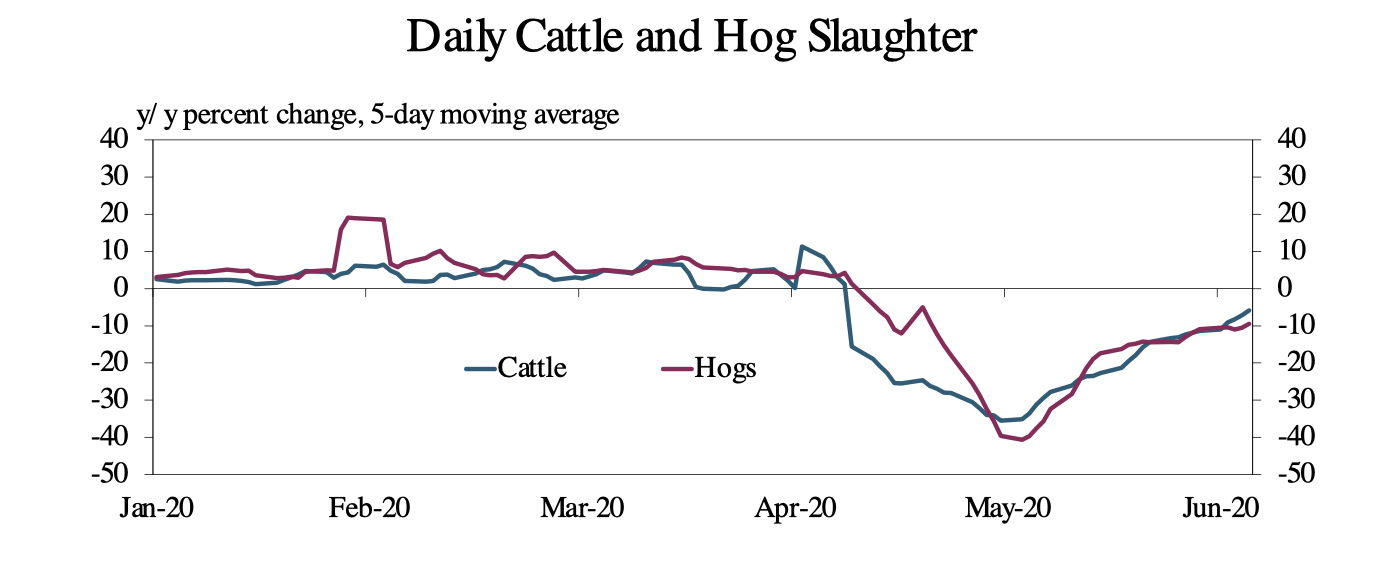
Source: Kansas City Fed, https://www.kansascityfed.org/research/agriculture?sm=rs061720
How might local foods increase flexibility in the US food system moving forward?
The events surrounding COVID-19 have increased our awareness of the vital role that local food systems can play in providing food security when national food systems break down or are impeded. Local food systems, often referred to as short supply chains, are flexible and can more easily pivot to serve new markets. While local food demand is strong (consumers concerned with empty grocery shelves during COVID-19 purchased produce and meat directly from local growers and ranchers, who saw large increases in community supported agriculture (CSA) program participation and online sales of their products, as much as 500% in some cases), it primarily functions with chefs, school buyers, and consumers, who purchase directly from growers at farmers’ markets, farm stands, and through CSA programs or grower websites. Many aspects of a strong local food system are missing, such as millers, processors, bakers, butchers, etc. Local, state, and federal policies which better enable the success and sustainability of local food systems are needed. In Utah, we have been early adopters in terms of policies that encourage strong local food systems, such as cottage food laws, herd share, raw milk/butter regulations, inspection of custom/private slaughter facilities, etc. But we can do even better to encourage growth at all stages of the supply chain in the future.
That’s all for now. If you have a topic you would like to see covered in a future blog, feel free to contact me.
Stay healthy!
Kynda Curtis, USU Extension Ag and Food Marketing Specialist
kynda.curtis@usu.edu
Online workshops, courses, webinars, and podcasts:
- USU Crops Virtual Field Day: https://docs.google.com/forms/d/e/1FAIpQLSeeg7I48oOE-BKzRTANZEF4sSmbNBcvQ4yEbC1vROT3e3234Q/viewform
- Idaho AgBiz Webinars: https://www.uidaho.edu/cals/idaho-agbiz
- Cultivating Success Webinars: https://www.cultivatingsuccess.org/home
Resources:
- USU Extension Farm Financial Health: https://extension.usu.edu/apec/farm-financial-health
- USU Extension COVID-19 Resources: https://extension.usu.edu/covid-19/
- Marketing in Motion Blog Posts: https://extension.usu.edu/apec/blog/
- UDAF Utah’s Own Program: https://www.utahsown.org
- UDAF COVID-19 Resources: https://ag.utah.gov/covid-19-news-and-updates/
- Taxes and Federal Programs: https://ruraltax.org
Disclaimer: This blog is for information purposes only. USU Extension does not endorse any specific product or service that may be mentioned here in.

